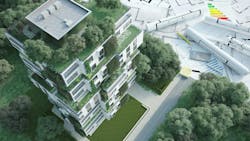How Sustainable Commercial Building Design Reduces Operating Costs
Key Highlights
-
High-performance envelopes, HVAC optimization, and LED lighting upgrades deliver strong ROI in both retrofits and new construction.
-
Smart systems and sensors enable real-time optimization, predictive maintenance, and long-term efficiency gains.
-
Water-saving solutions like greywater recycling and smart irrigation lower consumption and prevent costly damage.
-
Incentives, rebates, and third-party financing options help overcome upfront cost barriers and accelerate adoption.
Commercial property owners and managers face increasing pressure from escalating energy costs, environmental regulations, and tenant demands for sustainable workspace solutions. Traditional building operations consume enormous resources, translating to expenses that impact profitability and competitive positioning in today’s market.
Sustainable commercial building design offers a way to reduce operating costs while enhancing asset value and market competitiveness. Sustainable technologies and emerging innovative building design solutions create opportunities for cost optimization across energy, water, maintenance, and operational management systems. Thoughtful, properly implemented sustainable design strategies can help deliver returns while positioning buildings for long-term market success.
Core Principles of Sustainable Building Design: Energy, Water, and Materials
Sustainable commercial building design combines three core principles that directly impact operating costs. These include:
- Energy efficiency
- Water conservation
- Sustainable materials
These elements work together to create buildings that perform better and cost less to operate over time.
Building envelope performance is an important starting point for cost reduction. High-performance insulation, advanced windows, and proper air sealing can reduce HVAC loads, creating immediate savings. Passive design strategies—including smart building orientation, natural ventilation and daylight harvesting—further reduce energy needs while improving comfort and productivity.
Modern sustainable design easily integrates smart technologies at key points. Intelligent building management systems optimize energy use patterns, while advanced sensors monitor performance. This integration allows for predictive maintenance scheduling, prevents costly system failures and ensures sustained efficiency throughout the building’s life.
How Energy-Efficient Buildings Cut Operating Costs
Energy costs typically represent a significant portion of total commercial building operating expenses, making energy efficiency a high-impact area for cost reduction. High-performance building envelopes form the foundation of energy-efficient design, using advanced insulation materials, thermal bridge elimination, and high-performance windows that minimize heat transfer while maximizing natural light.
HVAC system optimization delivers savings through strategic zoning, variable air volume systems and high-efficiency equipment. Smart building design enhances these systems through intelligent controls that adjust heating, cooling, and ventilation based on occupancy and environmental conditions. Advanced building automation systems can significantly reduce HVAC energy consumption while maintaining comfort.
LED lighting systems and smart controls can save energy, lessening a building’s operational costs and environmental impact. LED lighting integrated with daylight harvesting controls and occupancy sensors creates additional cost savings compared to traditional lighting. Smart building design technologies enable precise lighting control, allowing spaces to adapt automatically to usage patterns while minimizing energy waste. These systems also provide valuable data about additional efficiency opportunities.
Water Conservation Strategies That Save Money in Commercial Properties
Water and wastewater costs continue rising across commercial markets, making water conservation a key part of cost management. Rainwater harvesting systems capture and store precipitation for landscape irrigation, cooling tower water, and other non-drinking applications, reducing municipal water consumption in typical commercial installations.
Greywater recycling systems treat and reuse water from sinks, showers, and cooling systems, creating closed-loop water management that can reduce consumption and discharge costs. Smart building design enhances these systems through automated monitoring and control technologies that optimize water treatment processes while ensuring consistent water quality and system reliability.
Smart irrigation systems integrate weather data, soil moisture sensors, and plant-specific watering requirements to minimize landscape water consumption while maintaining appearance. Advanced leak detection systems using wireless sensors and artificial intelligence can identify and locate water system problems before they create costly damage or waste, preventing immediate repair costs and ongoing efficiency losses.
Integrating Renewable Energy with Smart Building Technologies
On-site renewable energy generation represents an effective strategy for long-term cost reduction. Solar photovoltaic systems have become increasingly cost-competitive with grid electricity in most commercial markets, and many installations deliver cost benefits. Building-integrated photovoltaic systems serve dual functions as energy generators and building components, maximizing return on investment (ROI).
Energy storage systems paired with renewable generation enable peak demand shaving and time-of-use optimization, reducing electricity costs beyond the savings from renewable generation alone. Smart building design technologies optimize energy storage and distribution through predictive algorithms that anticipate building energy needs and electricity pricing patterns.
Smart sensors throughout the building monitor performance metrics, including temperature, humidity, air quality, and energy consumption patterns. This data enables continuous optimization of building systems while identifying maintenance needs before they impact efficiency. Green roofs and living wall systems provide additional insulation value while reducing stormwater management costs and creating improved indoor air quality that can reduce HVAC loads.
Real-World ROI: How Sustainable Buildings Deliver Measurable Results
Commercial buildings built using sustainable design strategies typically achieve operational cost reductions compared to conventional buildings. Energy cost savings can be significant, while water conservation measures add additional annual savings. Durable, sustainable materials and predictive maintenance systems reduce maintenance spending.
Retrofit projects can demonstrate energy cost reduction through building envelope upgrades, HVAC optimization, and LED lighting conversion. Smart building design components—including automated controls and energy management systems—often contribute significantly to the total savings achieved.
New construction projects can demonstrate greater cost reduction potential. Mixed-use developments can achieve impressive energy performance through sustainable design, generating annual operational savings compared to code-minimum construction. The premium paid out for sustainable design features can be recovered within a reasonable time frame (typically within 3-10 years) while creating ongoing value.
Water conservation systems in these projects can reduce water consumption, with smart irrigation and leak detection systems preventing costly damage while reducing operational oversight requirements. Building owners can also benefit from reduced insurance premiums and improved tenant satisfaction.
Sustainable Design Implementation: A Step-by-Step Roadmap for Building Owners
Sustainable design implementation begins with a building performance assessment and energy audit to identify the highest-impact opportunities for cost reduction. Professional energy audits reveal inefficiencies and quantify potential savings, enabling smart decision-making about upgrade priorities and investment strategies.
Prioritizing upgrades based on ROI helps ensure adequate resource allocation and cost reduction. Building envelope improvements, HVAC system optimization, and lighting upgrades typically offer strong returns.
Phased implementation strategies allow building owners to spread costs over time while capturing immediate savings from early-phase improvements. Many utility companies and government agencies offer rebates and incentives for sustainable building upgrades, with some programs covering significant portions of implementation costs. Power purchase agreements and energy service company (ESCO) financing help with implementation, with minimal upfront capital requirements and guaranteed performance results.
Overcoming Barriers and Embracing Future Trends in Sustainable Building Design
Upfront investment concerns represent a common barrier to sustainable design adoption despite proven long-term cost benefits. A comprehensive financial analysis—including a life cycle cost assessment that identifies opportunities, available incentives and financing options— typically reveals attractive returns. Third-party financing through ESCOs or green building loans can eliminate upfront cost barriers while ensuring performance guarantees.
Stakeholder education and buy-in strategies focus on quantified benefits and risk reduction rather than environmental messaging alone. Building owners respond to clear data about savings, tenant satisfaction improvements and asset value enhancement.
Emerging trends in sustainable commercial building design include AI-powered building optimization, advanced materials with improved performance characteristics, and smart building design technologies.
Regulatory changes drive market adoption, with many jurisdictions implementing mandatory energy performance standards and carbon reduction requirements that make sustainable design essential for market competitiveness.
How Sustainable Design Gives Your Building a Competitive Edge
Sustainable commercial building design delivers operational cost reductions while creating long-term competitive advantages through improved asset performance, tenant satisfaction, and market positioning.
Implementation success depends on strategic prioritization of high-impact improvements and integration of smart technologies that enable continuous optimization. Building owners who embrace sustainable design position themselves for sustained competitive advantage in an increasingly cost-conscious and environmentally aware commercial real estate market.
About the Author

Emily Newton
Emily Newton is an industrial and tech journalist passionate about how technology is revolutionizing each sector. She has been writing and editing professionally for more than five years and is the editor-in-chief of Revolutionized.
